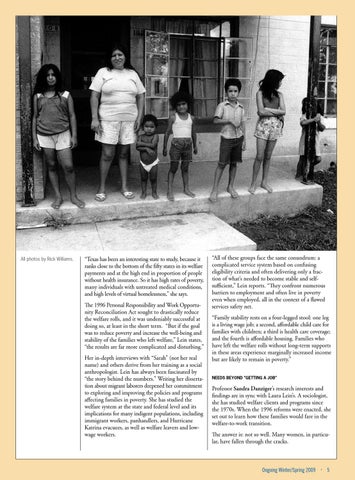Marian W
All photos by Rick Williams.
“Texas has been an interesting state to study, because it ranks close to the bottom of the fifty states in its welfare payments and at the high end in proportion of people without health insurance. So it has high rates of poverty, many individuals with untreated medical conditions, and high levels of virtual homelessness,” she says. The 1996 Personal Responsibility and Work Opportunity Reconciliation Act sought to drastically reduce the welfare rolls, and it was undeniably successful at doing so, at least in the short term. “But if the goal was to reduce poverty and increase the well-being and stability of the families who left welfare,” Lein states, “the results are far more complicated and disturbing.” Her in-depth interviews with “Sarah” (not her real name) and others derive from her training as a social anthropologist. Lein has always been fascinated by “the story behind the numbers.” Writing her dissertation about migrant laborers deepened her commitment to exploring and improving the policies and programs affecting families in poverty. She has studied the welfare system at the state and federal level and its implications for many indigent populations, including immigrant workers, panhandlers, and Hurricane Katrina evacuees, as well as welfare leavers and lowwage workers.
“All of these groups face the same conundrum: a complicated service system based on confusing eligibility criteria and often delivering only a fraction of what’s needed to become stable and selfsufficient,” Lein reports. “They confront numerous barriers to employment and often live in poverty even when employed, all in the context of a flawed services safety net. “Family stability rests on a four-legged stool: one leg is a living wage job; a second, affordable child care for families with children; a third is health care coverage; and the fourth is affordable housing. Families who have left the welfare rolls without long-term supports in these areas experience marginally increased income but are likely to remain in poverty.” Needs beyond “getting a job”
Professor Sandra Danziger’s research interests and findings are in sync with Laura Lein’s. A sociologist, she has studied welfare clients and programs since the 1970s. When the 1996 reforms were enacted, she set out to learn how these families would fare in the welfare-to-work transition. The answer is: not so well. Many women, in particular, have fallen through the cracks.
Ongoing Winter/Spring 2009
·
5
